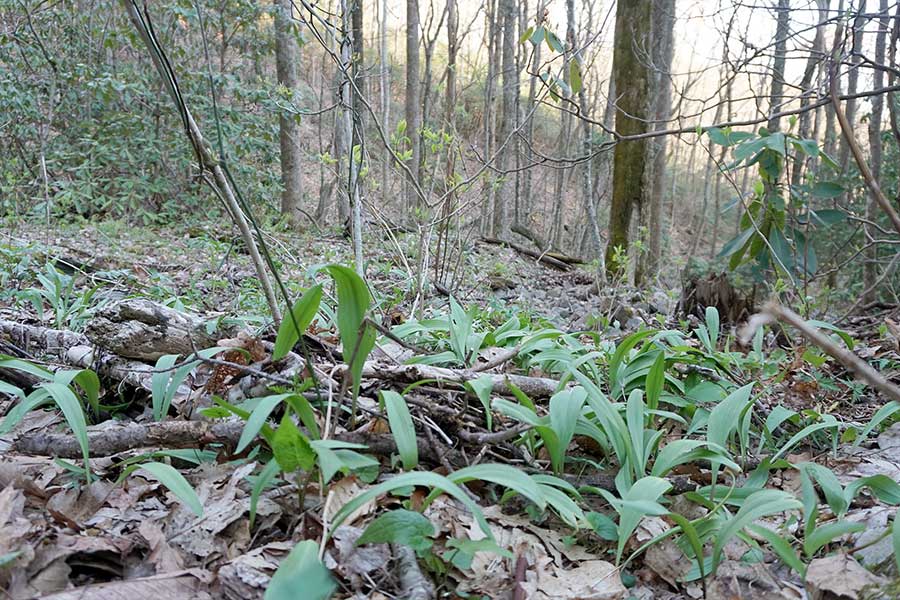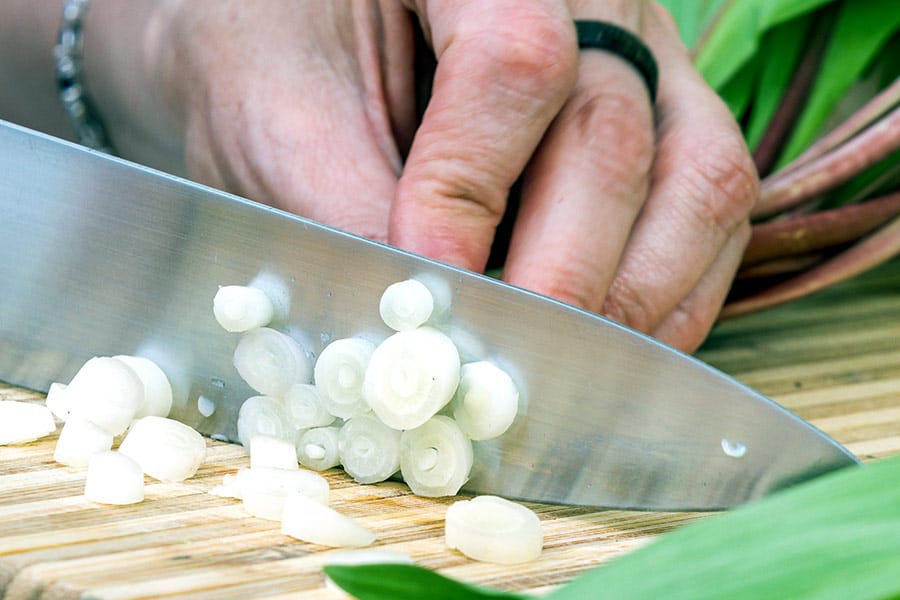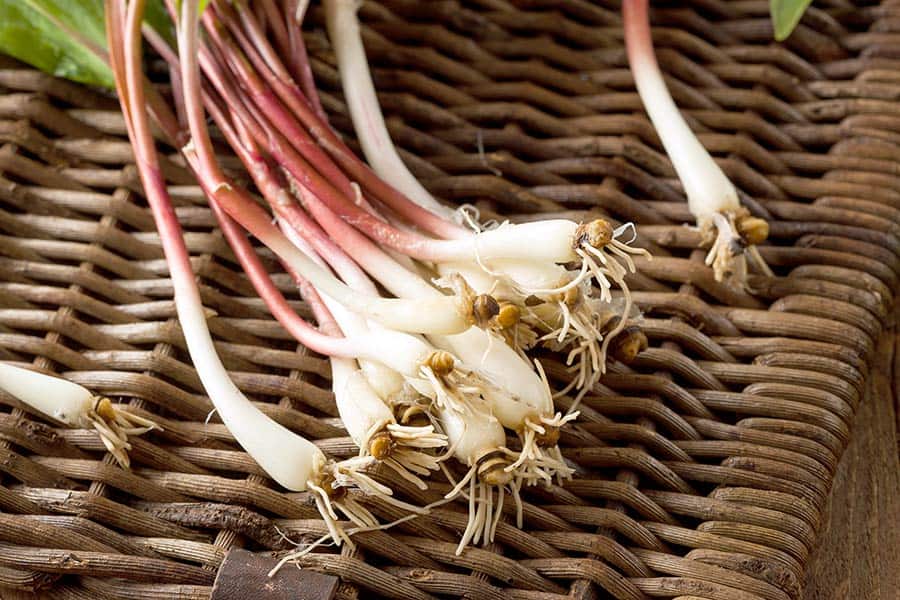
Foraging for food is becoming more and more popular. People love to forage for berries, fruit, mushrooms, tubers, and leeks! But will you find leeks growing wild in Pennsylvania?
Leeks do grow in the wild in Pennsylvania. Sometimes called ramps, wild leeks are found in the forest. They like to grow on the north slopes of hills or valleys. While it is legal (and fun!) to harvest leeks, it is essential to harvest responsibly so wild leeks will be here for future generations.
So, where can one find wild leeks in Pennsylvania? Are they easy to find? What is the best month to find leeks? Can you eat the whole thing, or is there only part of the leek you eat? Read on to learn more about wild leeks in Pennsylvania.
Wild Leeks in the Keystone State
Pennsylvania’s 16.7 million acres of forestland hold countless treasures for explorers of the wilderness. Hikers, campers, backpackers, and other outdoorsy types can find all kinds of flora and fauna out in the woods. One of the most notorious and sought-after plants in the Pennsylvania wilderness is the wild leek, scientifically called Allium Tricoccum but commonly known as the ramp.
Wild leeks have an earthy, oniony, garlicky flavor that is matched by a distinctive aroma. Their appearance is very similar to the Lily of the Valley, which is not edible. The easiest way to tell these plants apart is the smell: fresh, uncooked wild leeks are notorious for their strong smell and savory flavor.

While cooks use these plants in the same way as garlic or onions, they can be prepared in a myriad of ways. One popular method is to make a wild leek-infused vinegar, which makes a delectable salad dressing. Other people enjoy making pickled ramps, which are an excellent addition to any cheese board, and if you’d rather make your ramps the star of the show, you can make a delicious and nutritious ramp chowder.
Wild leeks are full of valuable nutrients and minerals. Indigenous people and early Appalachian settlers believed that they provided an essential infusion of vigor after a long, cold winter with no fresh plants to eat. In addition, it was thought that consuming wild leeks helped cleanse the blood and prevent illnesses like the flu.
It’s commonly believed that leeks and other alliums, such as onions, shallots, and garlic, have inherent disease-fighting properties. Some people believe that a diet rich in these plants helps reduce the risk of health problems such as cancer and mental issues such as dementia. Regardless of their specific qualities, the benefits of a diet rich in nutritious whole foods such as leeks are well-known.

The nutritional value of leeks is backed up by science. Leeks contain about as much vitamin C by weight as oranges do, making them an excellent source of this immune-boosting vitamin. Ramps are also an excellent source of compounds called thiosulfinates and cepaenes, which your body uses for a number of functions.
One of the most interesting uses of the wild leek is in vodka. CJ Spirits, a Pennsylvania distilling company, makes Wild’s Leek Vodka by infusing their corn-distilled vodka with wild leeks to get a deliciously savory, earthy spirit. The unique flavor of Pennsylvania leeks and vodka makes for a great bloody mary!
Another popular use of the wild leek is in wine. Brewing has long been a popular pastime in many parts of rural Pennsylvania, at first out of necessity and then out of passion. Among the many creative homebrews out there are ramp wines. Brewers use the ramp during the brewing process to create distinctively earthy wines from this flavorful little plant.
One of the best ways to find ramp wine is to go to a ramp festival. Ramps are culturally important to many Appalachian communities, as this region of the United States is famously self-reliant, and many residents supplement their food supplies through foraging or hunting. During the spring months, many rural Appalachian communities will have leek festivals and dinners to celebrate the appearance of this springtime vegetable.
Keystone Answers Fun Fact: The city of Chicago is named after the Menominee word for wild leeks, shika’ko.
Where Can I Find Wild Leeks in PA?
Wild leeks like to grow in the understory of the forest. They are native to Pennsylvania and will grow in pretty much any forested area. If you want to find wild leeks, grab a trowel and some hiking gear and head out into the woods.

Pennsylvania’s wild leeks seem to prefer north-facing slopes. North-facing slopes get less sunlight and tend to stay moister and a little cooler, which suits these hardy plants just fine.
While they are relatively easy to find, it’s important to be a good steward of wild leeks. It can take five to seven years for a wild leek to mature from a seed to an edible plant, and once it is dug up and consumed, it is gone.
Inexperienced, indifferent, or greedy foragers will often dig up an entire patch of these delicious plants, which will then take years to recover if it ever does. Such irresponsible behavior will eventually lead to the extinction of the wild leek.
Because of this problem and the demand for wild leeks, many foragers are intensely territorial and secretive about where they get their wild leeks.
Unfortunately, the high demand for this plant from trendy restauranteurs often drives unethical behavior by profit-hungry foragers. Only by being responsible and sharing public resources like wild leeks can we ensure that these tasty little plants will still be around for generations to come.
You may ask, can’t we just grow more wild leeks? The answer is yes, and no. Wild leeks are difficult to cultivate because they have a very long life cycle. Ramp seeds require a very specific set of temperature and moisture conditions before they will germinate. If conditions are not correct, the plant may decide to skip a year before growing. It can take up to 18 months for a single seed to germinate.
That said, it is possible to cultivate wild leeks in your own garden. Wild leeks like raised garden beds, and they also like being planted in areas that mimic their preferred natural setting. Those who have had success growing wild leeks report that the best way to manage your garden is to harvest no more than 10% of a patch at a time. If you are harvesting wild leeks in the forest, take no more than 5% of a leek patch to avoid depleting the leeks.

What Month Do You Dig Leeks in Pennsylvania?
Spring is a wonderful season for lots of reasons, but many Pennsylvanians love springtime because it signals the return of the wild leek. The best months for digging up wild leeks are March, April, and May. During these months, wild leeks get plenty of sunlight as the canopy of tree leaves has yet to grow back in from the winter.
By the time summer comes in June, Pennsylvania’s wild leeks are mostly done growing. Once the trees leaf in again, leeks produce a cluster of little white flowers, which look like clusters of snow in the underbrush.
What Part of Wild Leeks Do You Eat?
One of the best things about wild leeks is that the entire plant is edible. When you dig up a wild leek, you’ll notice that the pretty green leaves taper down to a small white root bulb. So while the actual root shoots are not edible, the bulb, stem, and leaves are all edible and delicious.
Most people find that the bulb of the wild leek has more flavor than the leaves. Therefore, many cooks use them in the same fashion as scallions, cutting the leaves for a lightly-flavored garnish and using the bulb for a more intense flavor sensation.
The flavor of wild leeks is more intense than a scallion or a store-bought leek but less intense than a true onion or a garlic clove. They are edible raw, but most people prefer to sauté them in butter or use them as a flavor component in a more complex dish. You can substitute them for scallions or commercially grown leeks, and they make a fine addition to soups, potatoes, eggs, and rice.
Other great uses for leeks include pasta, pestos, dips, and compound butter. You can even preserve them as a dried herb or pickle them for later use.
Note: We have also frozen the bulbs, and it works great for making caramelized onion and leek dip!
Ramping Down
Wild leeks, also called ramps, grow in the wild throughout Pennsylvania. These flavorful plants can be found in forests during the spring months, when they erupt from the forest floor to soak up the abundant spring sun. Wild leeks make a delicious addition to many dishes and can even be the centerpiece of meals like soup and chowder. So, grab a basket and some good boots, and head out to the woods for some responsible and enjoyable foraging. Pennsylvania’s wild leeks await you!






